
Examples
The case of a circular source
Let us examine the decrease in contrast produced by an extended source with a circular shape that is emitting a monochromatic radiation of
 . Figure 16 shows the notations. We note 2R the diameter of the source.
. Figure 16 shows the notations. We note 2R the diameter of the source.
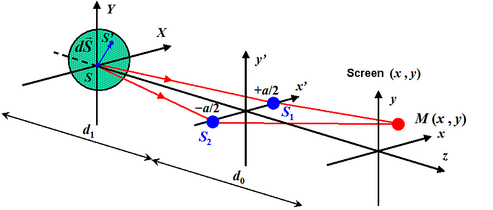
The circular source has a uniform brightness that can be described by the following function:
The Fourier transform of the source's angular distribution is given by:
The source has a circular symmetry; we can use a transformation in polar coordinates for (X , Y) and
 , i.e.:
, i.e.:
thus,
or also:
considering that:
J0 being the Bessel function of the first kind of order 0, we have:
Due to the definition of the brightness function, it follows that:
Assuming
 , we obtain:
, we obtain:
along with the equality:
J1 being the Bessel function of order 1 such that
 , we finally obtain:
, we finally obtain:
Since we have (figure 16):
the degree of spatial coherence of the circular source is finally written as
 :
:
The formula for the degree of spatial coherence of the circular source is
 where
where
 . Figure 17 shows the outline of the degree of spatial coherence of the circular source as a function of the value of Z expressed in radians.
. Figure 17 shows the outline of the degree of spatial coherence of the circular source as a function of the value of Z expressed in radians.
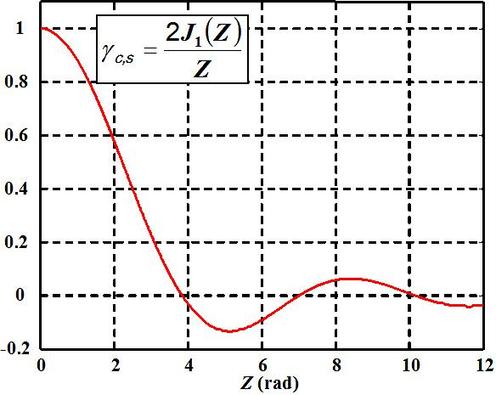
Table 2 gives the values of Z for maxima, minima, and zeros of the degree of coherence.
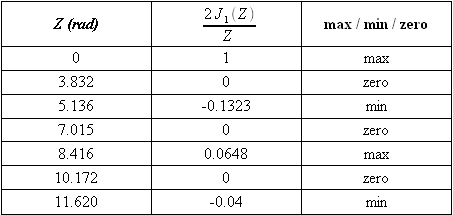
The zeroes of the degree of spatial coherence are not equidistant. The first contrast cancellation is obtained by:
i.e. by a distance between the secondary sources that is equal to:
Remember that 2R represents the source diameter.
As a result of the angular diameter
 from which the source is seen from the plane of the secondary sources, we obtain:
from which the source is seen from the plane of the secondary sources, we obtain:
As a numerical example, let us consider the case of the Sun for which the apparent angle of observation from Earth is
 . The preceding relation gives
. The preceding relation gives
 for
for
 . If we want to observe contrasted interferences at a point M on the screen, the secondary sources must not be separated by a distance greater than this value. Sunlight, therefore, has a weak spatial coherence.
. If we want to observe contrasted interferences at a point M on the screen, the secondary sources must not be separated by a distance greater than this value. Sunlight, therefore, has a weak spatial coherence.
For secondary sources of the same amplitude, the interference signal at a point M on the screen can be written as:
Figure 18 shows the interferograms obtained for the different values of the degree of coherence on a screen.
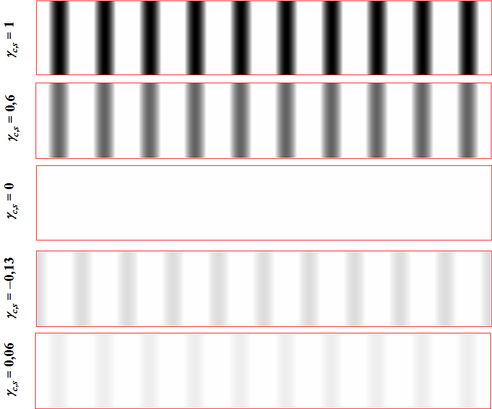
The fringe contrast evolves as a result of the source radius R following the curve in figure 17. If the value of R is low, the fringe contrast is ostensibly equal to the unit. As R increases, the contrast diminishes and eventually becomes null when
 . Then, when the contrast becomes nevative, the bright fringes occupy the position of the dark fringes and vice versa; this inversion can be observed quite easily in figure 18, even if the contrast is rather weak
. Then, when the contrast becomes nevative, the bright fringes occupy the position of the dark fringes and vice versa; this inversion can be observed quite easily in figure 18, even if the contrast is rather weak
 . If the value of R continues to increase, the fringes become less and less visible until they disappear completely.
. If the value of R continues to increase, the fringes become less and less visible until they disappear completely.
The case of a rectangular source
Now let us examine the decrease in contrast caused by an extended source with a rectangular shape. Figure 19 shows the notations. We note
 as the dimensions of the source.
as the dimensions of the source.
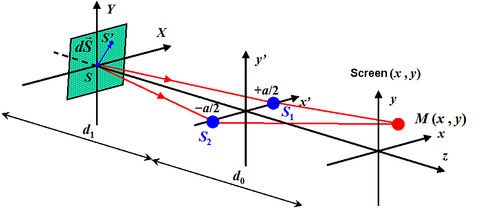
The circular source has a uniform luminance that can be described by the following function:
The Fourier transform of the light distribution of the source is given by:
Keeping in mind the definition of the brightness function, we have:
This expression can be easily integrated, so we find that:
Since the secondary sources are reduced to two points,
 , we have:
, we have:
For the case illustrated in figure 19, the degree of spatial coherence of the rectangular source is written as:
The degree of spatial coherence of a rectangular source has the shape of a sinc function. Figure 20 shows the shape of the degree of spatial coherence of the rectangular source as a function of the value of Z expressed in radians.
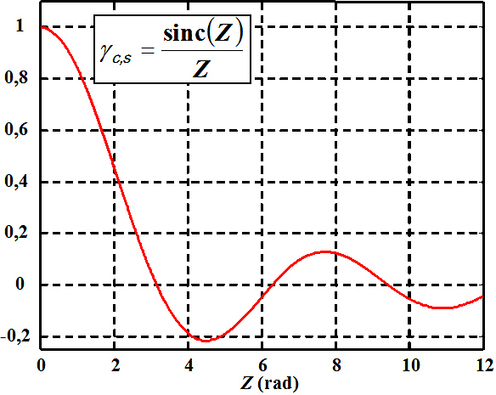
The zeroes of the degree of coherence are equidistant. The contrast is cancelled at:
The first zero is obtained for the distance between the secondary sources that is equal to:
This expression gives us an estimate of the width of the spatial coherence of the source.